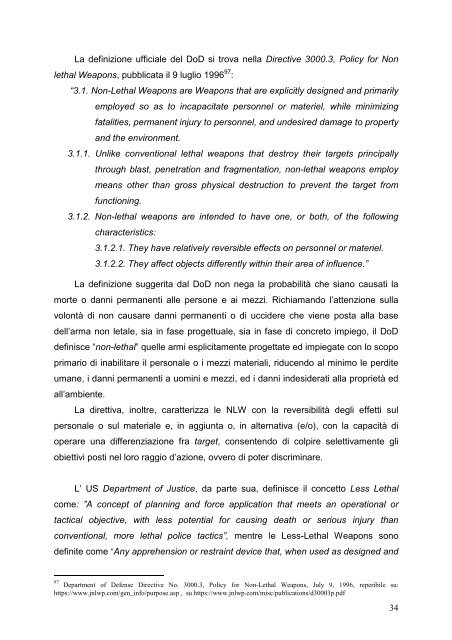Le armi cosiddette non letali - Assemblea dell'Officina di Fisica
Le armi cosiddette non letali - Assemblea dell'Officina di Fisica
Le armi cosiddette non letali - Assemblea dell'Officina di Fisica
Create successful ePaper yourself
Turn your PDF publications into a flip-book with our unique Google optimized e-Paper software.
La definizione ufficiale del DoD si trova nella Directive 3000.3, Policy for Non<br />
lethal Weapons, pubblicata il 9 luglio 1996 97 :<br />
“3.1. Non-<strong>Le</strong>thal Weapons are Weapons that are explicitly designed and primarily<br />
employed so as to incapacitate personnel or materiel, while minimizing<br />
fatalities, permanent injury to personnel, and undesired damage to property<br />
and the environment.<br />
3.1.1. Unlike conventional lethal weapons that destroy their targets principally<br />
through blast, penetration and fragmentation, <strong>non</strong>-lethal weapons employ<br />
means other than gross physical destruction to prevent the target from<br />
functioning.<br />
3.1.2. Non-lethal weapons are intended to have one, or both, of the following<br />
characteristics:<br />
3.1.2.1. They have relatively reversible effects on personnel or materiel.<br />
3.1.2.2. They affect objects <strong>di</strong>fferently within their area of influence.”<br />
La definizione suggerita dal DoD <strong>non</strong> nega la probabilità che siano causati la<br />
morte o danni permanenti alle persone e ai mezzi. Richiamando l’attenzione sulla<br />
volontà <strong>di</strong> <strong>non</strong> causare danni permanenti o <strong>di</strong> uccidere che viene posta alla base<br />
dell’arma <strong>non</strong> letale, sia in fase progettuale, sia in fase <strong>di</strong> concreto impiego, il DoD<br />
definisce “<strong>non</strong>-lethal” quelle <strong>armi</strong> esplicitamente progettate ed impiegate con lo scopo<br />
primario <strong>di</strong> inabilitare il personale o i mezzi materiali, riducendo al minimo le per<strong>di</strong>te<br />
umane, i danni permanenti a uomini e mezzi, ed i danni indesiderati alla proprietà ed<br />
all’ambiente.<br />
La <strong>di</strong>rettiva, inoltre, caratterizza le NLW con la reversibilità degli effetti sul<br />
personale o sul materiale e, in aggiunta o, in alternativa (e/o), con la capacità <strong>di</strong><br />
operare una <strong>di</strong>fferenziazione fra target, consentendo <strong>di</strong> colpire selettivamente gli<br />
obiettivi posti nel loro raggio d’azione, ovvero <strong>di</strong> poter <strong>di</strong>scriminare.<br />
L’ US Department of Justice, da parte sua, definisce il concetto <strong>Le</strong>ss <strong>Le</strong>thal<br />
come: ”A concept of planning and force application that meets an operational or<br />
tactical objective, with less potential for causing death or serious injury than<br />
conventional, more lethal police tactics”, mentre le <strong>Le</strong>ss-<strong>Le</strong>thal Weapons sono<br />
definite come “Any apprehension or restraint device that, when used as designed and<br />
97 Department of Defense Directive No. 3000.3, Policy for Non-<strong>Le</strong>thal Weapons, July 9, 1996, reperibile su:<br />
https://www.jnlwp.com/gen_info/purpose.asp , su https://www.jnlwp.com/misc/publications/d30003p.pdf<br />
34


